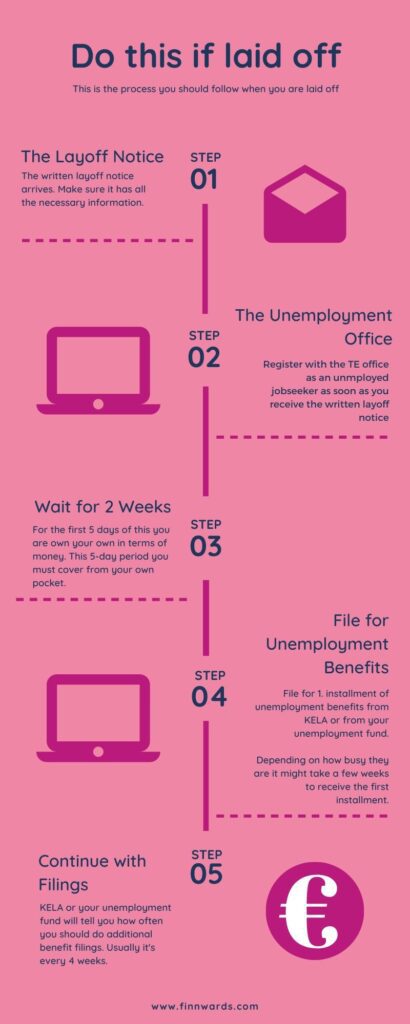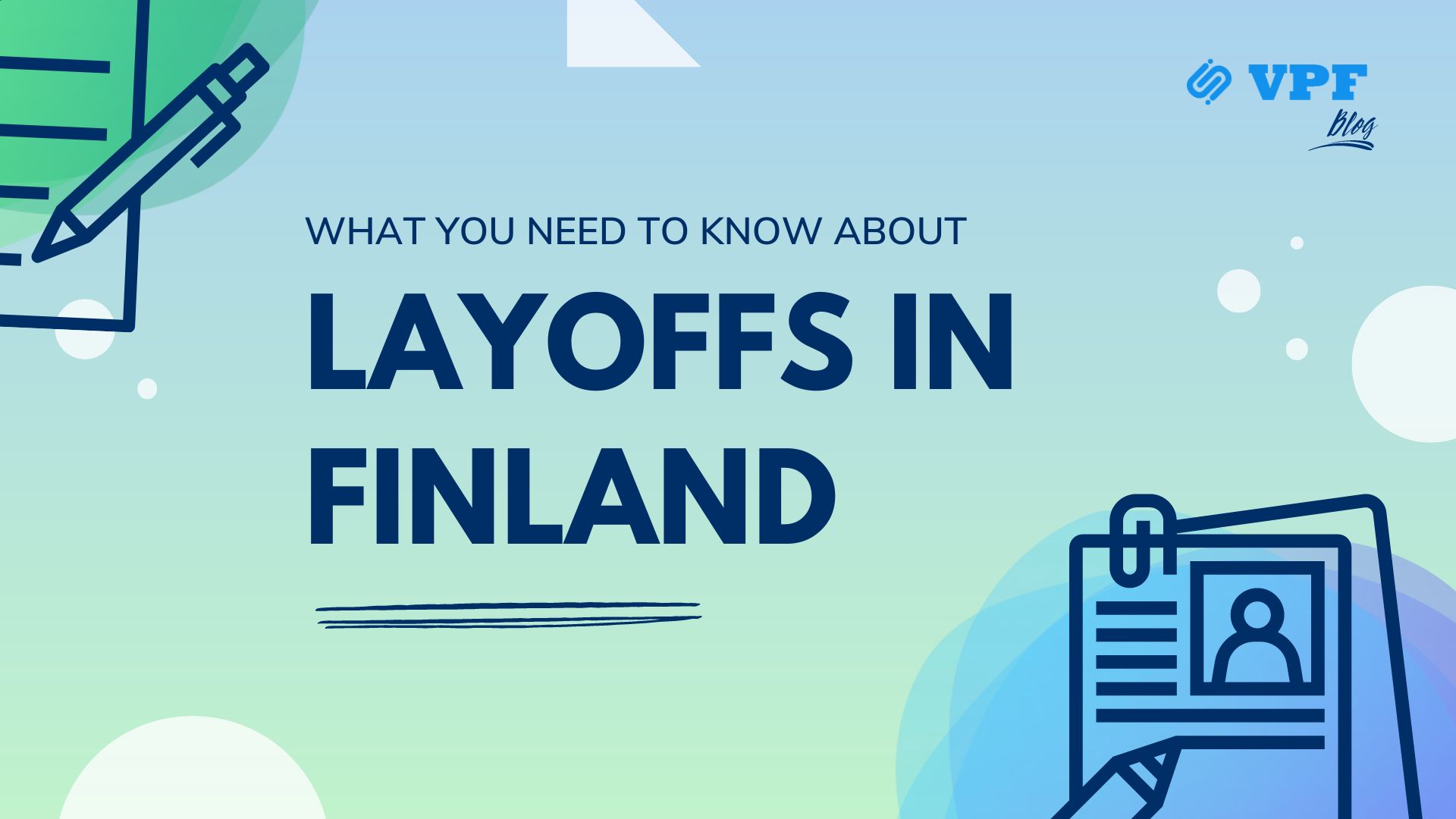The past few years have taught us that many unprecedented events can have a drastic negative impact on the economy and the labor market, thus putting both businesses and professionals in a very difficult position. These often result in layoffs. Without a prepared mind and a set of fundamental knowledge, it will be a real struggle to come out of these situations in good shape. Therefore, we have gathered useful information about layoffs in Finland to help you weather the storm if it ever crosses your way.
What is layoff?
According to the Ministry of Economic Affairs and Employment of Finland, a layoff means temporary termination of work and the payment of wages and salaries, while the employment relationship remains in effect in other respects.
A full-time layoff means you are suspended from work until further notice, whereas a part-time one means a reduction in your working hours, which can last up to 90 days.
Before a layoff
Negotiation and notice period
When a need for layoffs becomes known, it is your employer’s responsibility to provide clear explanations and details of the layoff, as follows:
- the grounds for the layoff
- the starting time of the layoff
- its duration or estimated duration
The employer must give the employees or their representative an opportunity to be heard concerning the explanation given. For companies employing at least 20 people, they must follow the cooperation negotiation process. In this case, your workplace’s employee representative will discuss with the employer how to mitigate the layoff impacts on the affected employees.
Once a mutual agreement for the layoff is made, the employer must present the affected employees with a layoff notice no later than 14 days before the start of the layoff. Layoffs in well-being services counties and local government must be announced at least one month in advance.
Unemployment benefits
What is the most important thing to know when it comes to layoffs? Unemployment benefits.
1. Where do you get unemployment benefits from?
You can gain unemployment benefits from Kela or from your unemployment fund.
You should seek support from Kela only when you are not part of any labor union, unemployment fund, or when you are not yet eligible to receive unemployment allowance from the unemployment fund. The reason is that Kela grants you a standard and lower allowance compared to what an unemployment fund will pay you.
2. How and how much?
In order to receive earnings-related allowances from an unemployment fund, you must meet the employment condition, which means working at least 18 hours for 26 calendar weeks or 6 months. There are many different unemployment funds, each of which has its own criteria for membership. Therefore, make sure to do your research on a suitable unemployment fund as soon as you can and join one that fits your needs so that when there is a layoff possibility, you come prepared.
One thing to note is that you do not have to be part of a labor union in order to be eligible for benefits from an unemployment fund. You can, in fact, become a member directly at any unemployment fund.
The amount of allowance an unemployment fund will pay you is based on your monthly salary, decided per a complex set of formulas. You can check your estimated allowance using your fund’s allowance calculator. Usually this amount is higher than what Kela will pay you, because it already takes into account that basic allowance.
The unemployment benefit paid by Kela amounts to EUR 37.21 per day. The benefit is paid for five days per week (including mid-week holidays).
According to KOKO unemployment fund, earnings-related security is accumulated by all kinds of paid work per the employment condition.
Moreover, your unemployment allowance is taxable, and the amount of unemployment benefit will also be adjusted based on whether you have any dependants or if you have some earnings during the layoff period that exceed their exempt limits.
3. What about part-time employees and students?
As a student or a part-time employee, you are entirely eligible to join an unemployment fund. The work does not have to be from one time period only: as a student, you can accumulate working weeks for several years, for example in summer jobs.
On the other hand, there cannot be any interruptions in the membership of the unemployment fund. So, after you join, stay a member of the fund throughout your studies – even if you don’t work alongside your studies all the time.
You may not receive an unemployment allowance if the TE Office determines that your studies are full-time, even if you have been working at the same time before the layoff. Check this information with the TE Office.
During a layoff
Now you are one of the unlucky ones, what’s next?

(Source: Finnwards)
Rights and responsibilities
Since you still have a valid employment relationship with the employer, you are still entitled to certain fringe benefits, such as occupational health care and accommodation. During a layoff, an employee generally accrues annual holidays for a maximum of 30 working days at a time. In addition, a laid-off employee can accept other job offers, but note that this may affect his/her unemployment allowance amount.
If you are laid off when going on sick leave, the employer has an obligation under the collective agreement to pay wages for the duration of the sick leave. The layoff comes into force only after the sick leave has ended.
Depending on the nature of your studies, you may still receive the unemployment allowance. More specifically, if the TE Office has determined your studies to be full-time, the unemployment fund will not be able to pay you a daily allowance. The TE Office can consider your full-time studies as a secondary activity under certain conditions, which will allow you to receive the unemployment benefits.
In regards to holiday pay and holiday bonus during a layoff period, here is a quick summary from PAM:
- Full-time worker = holiday pay and holiday bonus are not adjusted and unemployment allowance is not paid for the holiday period.
- Part-time worker = holiday pay and holiday bonus are adjusted based on the date of payment within the application period and unemployment allowance is paid for the holiday period.
In addition to all the aforementioned rights, your responsibilities include:
- Not working for a competitor or establishing a competing business
- Not causing harm to your employer
- Protect employer’s confidential information and documents
Step-by-step actions
As soon as you receive the layoff notice from your employer, follow the steps below:
- Register with TE Services as an unemployed jobseeker.
- Apply for unemployment benefits online, either through your unemployment fund or Kela.
- Prepare all the necessary documents.
- Wait for your decision. Usually at Kela, the waiting period is 5 working days.
- File an unemployment status report online every 4 weeks. As a rule, Kela pays a basic unemployment allowance for a maximum of 400 days. After that, it is possible to apply for a labor market subsidy.
- Find a new job or return to your current workplace if your employer decides to end the layoff.
Resignation mid-layoff
If the laid-off employee finds a job somewhere else, he/she is entitled to terminate the employment contract made with the other employer during the layoff with a 5-day notice. A fixed-term employment contract can also be terminated in this situation. An employee can also give notice without a period of notice if he/she does this earlier than 7 days before the end of the lay-off.
If you resign after you have been continuously laid off for more than 200 calendar days, you will be entitled to severance pay as well as holiday compensation.
After a layoff
Your employer might suspend or end your layoff earlier than the initially planned date. If the employer decides to ask you to resume work, they must give you a notice of at least 7 days before work starts and the layoff ends. You should accept the offer and resume work so as to maintain your unemployment security. Do not forget to inform the TE Office and update your unemployment status.
On the other hand, your employer can extend the layoff. In this case, they must organize another cooperation negotiation and follow the 14-day layoff notice period.
According to the Occupational Safety and Health Administration in Finland, if the employer terminates a laid-off employee’s employment contract by giving notice so that the contract ends during the layoff, the employee is entitled to severance pay.
Final words
If you ever find yourself in this difficult situation, make sure to always stay calm and read the instructions carefully. Better times are ahead of us – just remember to stay strong!
Author’s bio
Ha Tran, Co-Lead of the Medium and Communications team, is currently working in the Marketing Operations function at Supermetrics. She loves writing and traveling to meet new people and enjoy new cuisines.
